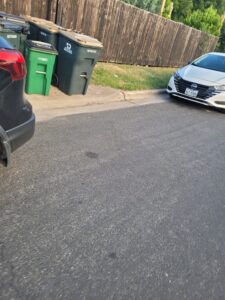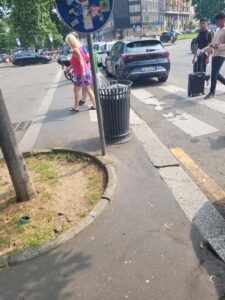Let’s face it, when it comes to just about anything the one-size-fits-all label never actually does. I’ve known this my whole life with clothing – I am 6 feet tall, I have never encountered a one-size item of clothing with long enough sleeves or pant legs to fit my body. Similarily, one size clothing rarely fits anyone who wears over a size Medium. Seeing the “OS” label on something automatically informs me that I am excluded. People and bodies are diverse, the idea that one size could fit all or even “most” is a joke.
That applies to disability and accessibility as well. Disability covers a wide range of differences even amongst just physical disabilities. The needs of a blind person are very different from those of a wheelchair user. And even among wheelchair users an ambulatory wheelchair user’s needs differ from a paraplegic’s which differ from a quadriplegic’s which differ from an amputee’s. There is of course some overlap, but no single approach to accessibility will meet everyone’s needs.

In fact, there are times when disabilities may be in conflict (a concept known as access friction). The textured pavement that helps vision impaired people know where curb cuts are located can be very painful for wheelchair users to roll over. The ramp wheelchairs require is impossible to use for people who can only navigate flat not sloped surfaces. The service dog that helps one person could trigger the severe allergies of another person. The facemask that an immunocompromised person must wear to stay safe impedes those with hearing loss from reading their lips. I faced this conflict once when I was speaking at a conference and received complaints that the lapel microphone wasn’t picking up my voice loud enough for some people with hearing loss so they requested I use a handheld one up close to my lips – it was a great idea except that I only have one hand which meant that by holding the mic with that hand I could not use my notes or gesture making me feel very constrained. Needs differ. Nothing is ever fully accessible because needs are vast and can be in conflict.
I try to stay aware of that fact as I blog on this site. I am sharing from my personal experience as an ambulatory wheelchair user who also has POTS and an upper limb difference. The sorts of accessibility that work for me might not be enough for someone else, so whenever I address if a certain activity or place is accessible it is with significant caveats.
In the United States the Americans with Disabilities Act has put laws in place to require many buildings to meet a certain minimum of accessibility – generally meaning that there needs to be a way for wheelchair users to get in the building, travel floor to floor, and have access to a bathroom. This is helpful but barely meets the bare minimum. Often that accessible entrance means traveling around multiple city blocks and down a back alley to enter by a ramp next to the dumpsters – making that entrance unsafe and demeaning to the wheelchair user. Elevators are not always kept up and can sit broken for months, but one exists so it counts for legal purposes. Most so-called accessible bathrooms simply mean there is one stall that is slightly wider and has a grab bar installed somewhere – but often those stalls don’t even come close to being wide enough for a wheelchair to enter much less maneuver and just because a grab bar exists doesn’t mean it is placed anywhere that is useful. Ticking off a box to meet the bare minimum legal requirements does not accessibility make.

Bringing awareness to how accessible places really are is something I know I would benefit from and so I want to share what I have learned with others. Those with physical disabilities know the emotional labor that we must do before we go anywhere – scouring Google maps to see if there is accessible parking, curb cuts, or steps at an entrance (and hope some jerk hasn’t blocked our access with a shopping cart or discarded scooter or by parking illegally). We have to check every website to find where they buried their accessibility information. We have to call ahead to ensure that elevators are operational and cross our fingers that we are told the truth. And sometimes we must set off bravely not knowing if we can access the place we want to go and prepare ourselves for disappointment if we find our way blocked.
So, as I talk about accessibility here on this blog I acknowledge that I am only doing so from a certain point of view. I know that saying a place is accessible simply because I could enter the building in a wheelchair does not cover the range of accessibility needs, and yet being able to enter a building in many countries can be rare and I will point it out. Similarly, I primarily focus on the needs of those with physical disabilities here – especially those who use wheelchairs.
I know what I am trying to do here isn’t fully inclusive because “fully accessible” is a myth just like one-size-fits-all. Maybe my accessibility needs match up or at least overlap with some of yours. And for that I will try my best to help.
